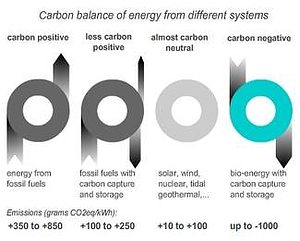As climate change and global warming become ever pressing issues on the desks of the world’s governments, so do the much awaited measures become more prevailing, albeit not nearly as thoughtfully as they should be addressed. Today, renewable energy sources like solar and wind have actually ceased to become regarded as “alternative”, since actually more capacity of renewable energy was added than other in both the United States and in Europe.
Whether you choose to believe in human induced climate change or not, the truth of the matter is, no matter what side of the fence you’re on, growing carbon dioxide emissions in the atmosphere signify a grave peril to humanity, life on Earth and nature’s balance.

Efforts to curb emissions levels have gone a long way in the past few decades, and for this we can only be grateful to all the engineers, scientists, and not lastly government officials who had the vision and courage to listen and voice the right measures for the good of our planet and generations to come.
Still…with all this measure at play, in the year 2011 global greenhouse gas emissions reached a new record, since developing countries are burning fossil fuels at an alarming rate as they seek to level the game with other developed countries. It’s becoming clear than reducing emission isn’t enough.
Recently, Stanford University released a report in which it highlights solutions for cutting carbon emissions, as in removing them altogether, instead of simply reducing them, as part of the university’s Global Climate and Energy Project (GCEP). These methods and solutions are commonly referred to as carbon-negative technologies, and some of them have been described in the report.
“To achieve the targeted cuts, we would need a scenario where, by the middle of the century, the global economy is transitioning from net positive to net negative CO2 emissions,” said report co-authorChris Field, a professor of biology and of environmental Earth system science at Stanford. “We need to start thinking about how to implement a negative-emissions energy strategy on a global scale.”
Negative carbon means a more positive environment
Negative carbon emission occurs when more carbon is sequestered than it is released in the atmosphere, and of the technologies that can allow this is s BECCS, or bioenergy with carbon capture and storage. Typically, BECCS converts woody biomass, grass and other vegetation into electricity, chemical products or fuels, such as ethanol. Where it shines however is in it capability of trapping carbon.
In a way, the system is very similar to how plants work. During photosynthesis plants absorb carbon dioxide and store it, before releasing it back in the atmosphere when the plants dies and decays. With BECCS however, the captured carbon doesn’t need to be released back, instead it can be stored underground.
In the GCEP Stanford report, a conclusive example is being given in the form of a Department of Energy sponsored corn ethanol production facility in Decatur, Ill. Here, some 1,000 metric tons of CO2 emitted during ethanol fermentation are captured and stored in a sandstone formation some 7,000 feet underground. Ultimately, the goal of the project is to sequester 1 million metric tons of CO2 a year – the equivalent of removing 200,000 automobiles from the road.
Estimates show that by 2050, BECCS technologies could sequester 10 billion metric tons of industrial CO2emissions annually worldwide. This, of course, if the technology is backed up by solid investment.
“To meet ambitious climate targets, a cost-effective policy would be to implement a carbon tax and to recycle the revenues to subsidize captured emissions from biomass,” said Olivia Ricci of the University of Orléans in France.
Biochar and other carbon-negative technologies
Another carbon-negative technology, rather similar to BECCS but with distinct differences, is biochar. Similar to charcoal, biochar is the byproduct of plants, only it is produced through the heating of vegetation without oxygen, a process typically referred to as pyrolysis. Carbon-rich chunks of biochar are thus made that can be put in the soil trapping the carbon, while acting as a soil fertilizer at the same time.
Biochar systems can be net negative if the biochar is made from waste biomass, sustainably harvested crop residues or crops grown on abandoned land that has not reverted to forest. On a global scale, using biochar could result in the sequestration of billions of metric tons of carbon a year, however scientists warn that biochar instability might occur if concentrations are too great. I recommend reading my colleague’s piece on how biochar could save millions of lives, for more info on the subject.
“Estimates of biochar half‐life vary greatly from 10 years to more than 100 years. The type of feedstock also contributes to stability, with wood being more stable than grasses and manure,” the authors of the report write.
Sequestrating carbon in the ocean has been a proposal for many years, and is also considered a viable solution discussed in the raport. Today, ocean acidification is a matter of great concern, as an increased uptake of atmospheric CO2 causes seawater to become more acidic, putting the ecosystem at great peril. It is believed ocean acidification is reaching a 300 million year old peak, something that might trigger the extinction of massive amounts of marine life.
The authors cited research by David Keith of Harvard University suggesting that magnesium carbonate and other minerals could be added to the ocean to reduce acidity and sequester atmospheric CO2 absorbed in seawater in the process.
Like in the case of biochar, however, sequestrating immense amounts of carbon in the world’s oceans is a rather extreme measure and the full effects of such an endeavor are yet to be fully understood. “The associated risks to the marine environment need to be adequately assessed,” the authors concluded.
Other technologies discussed in the report, which can read in full here, are carbon-negative large agricultural systems and “artificial trees”.
source: Stanford.


